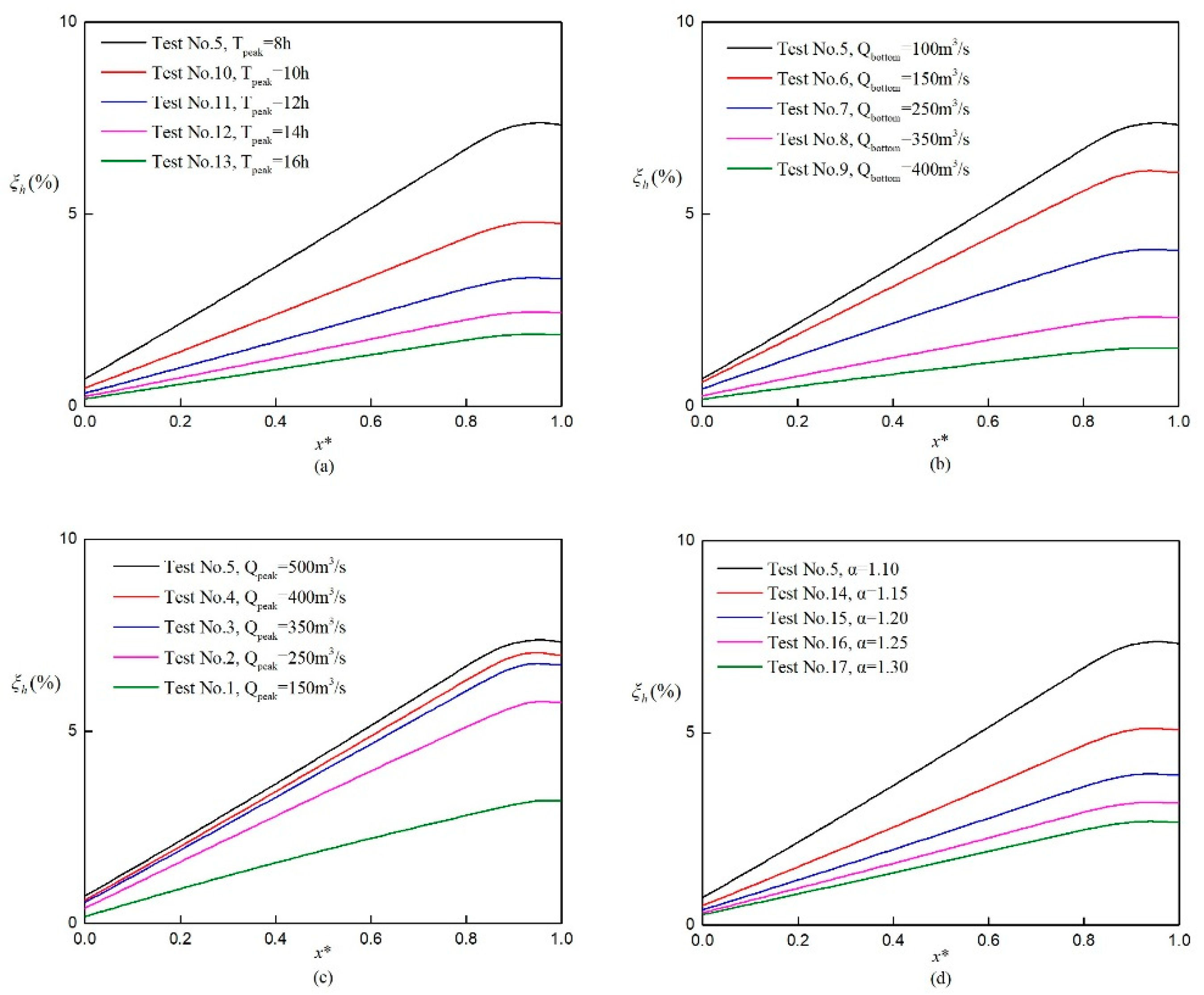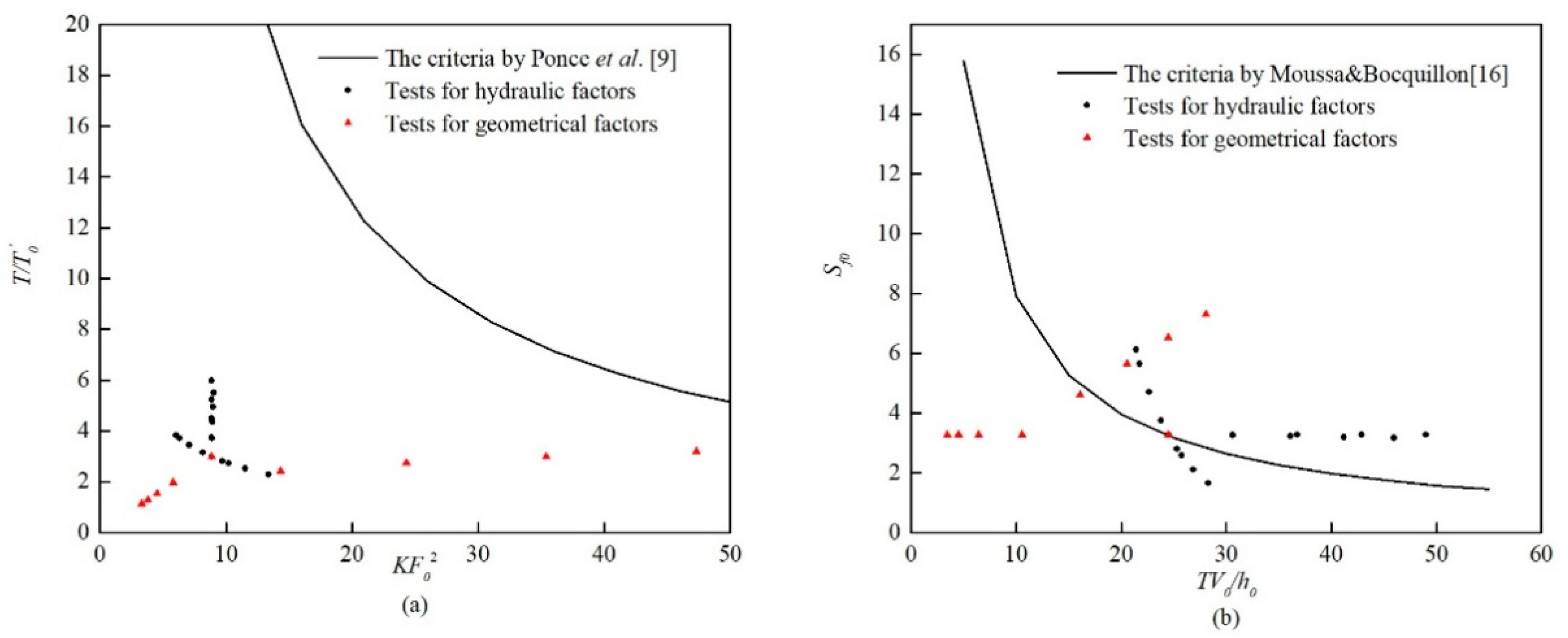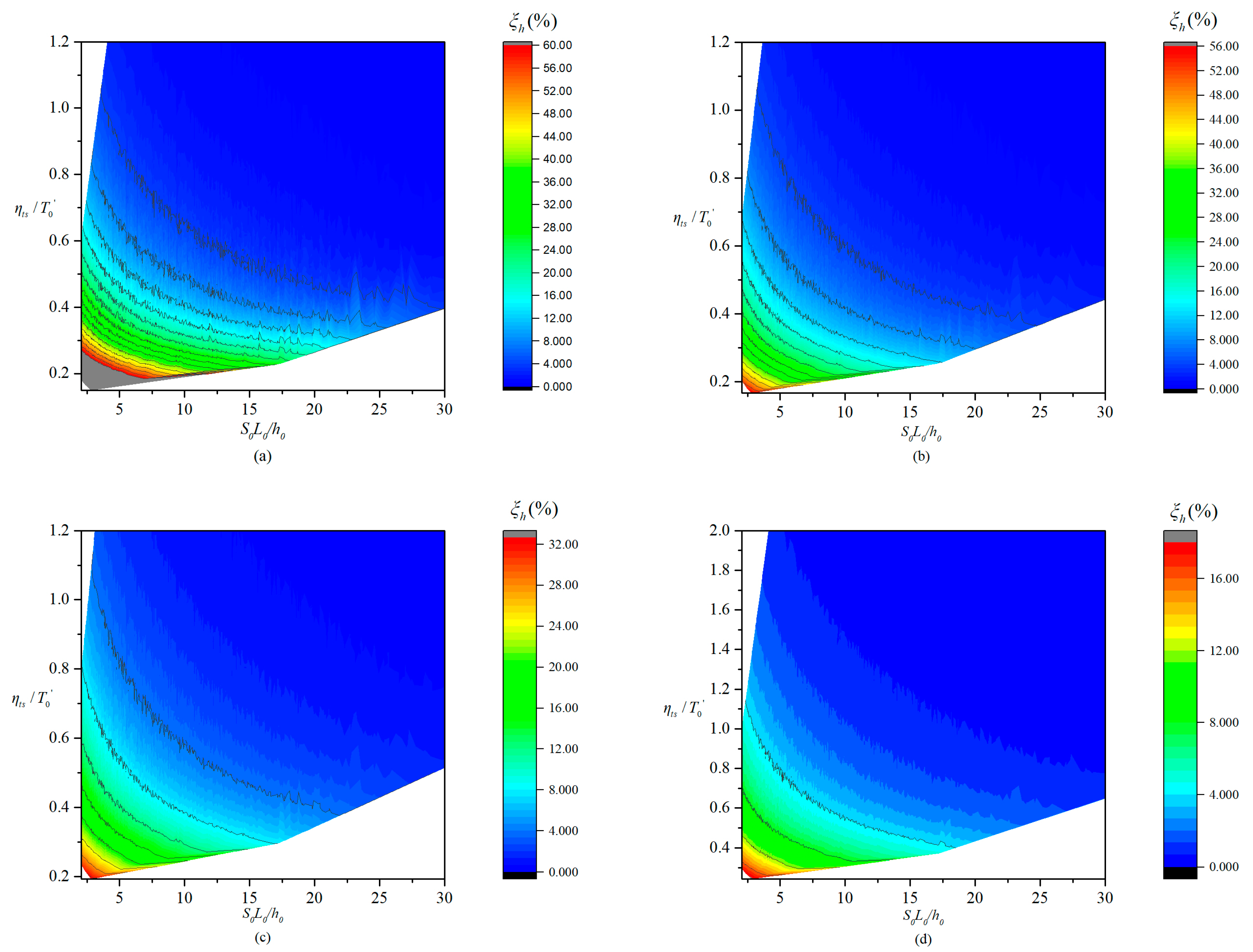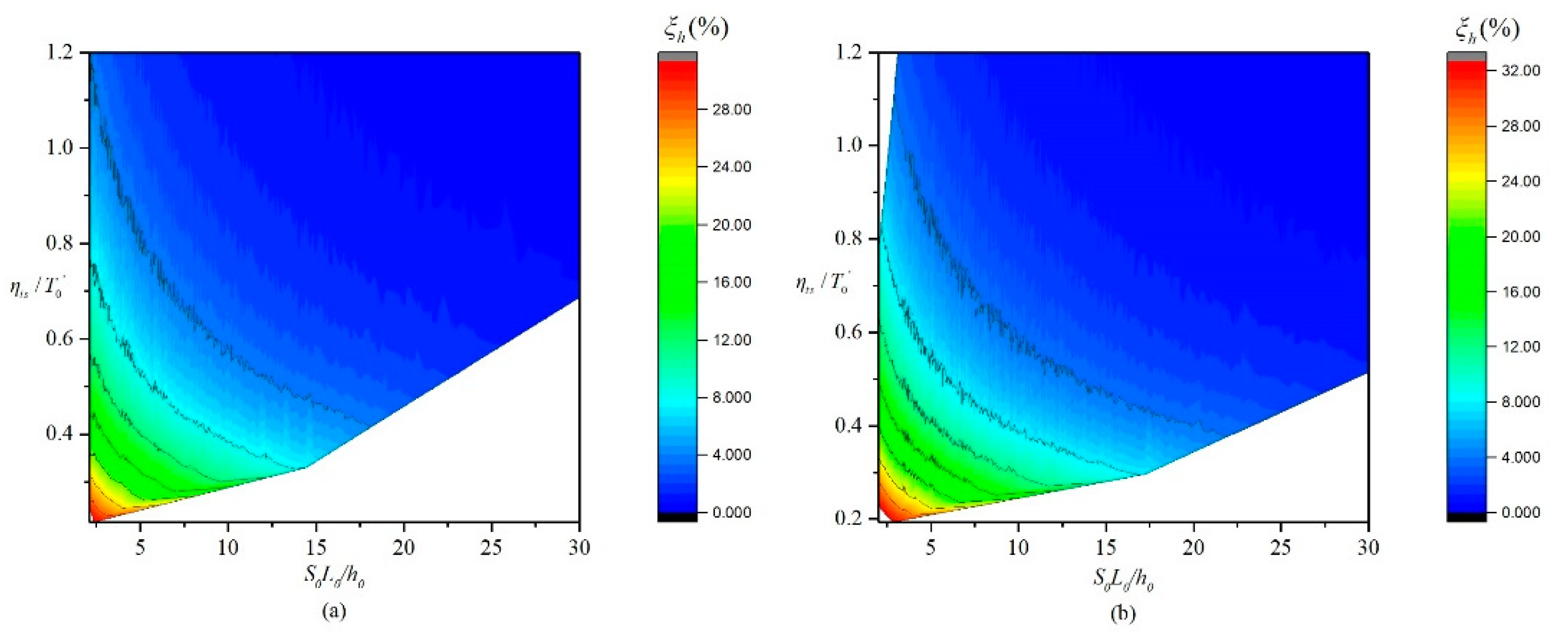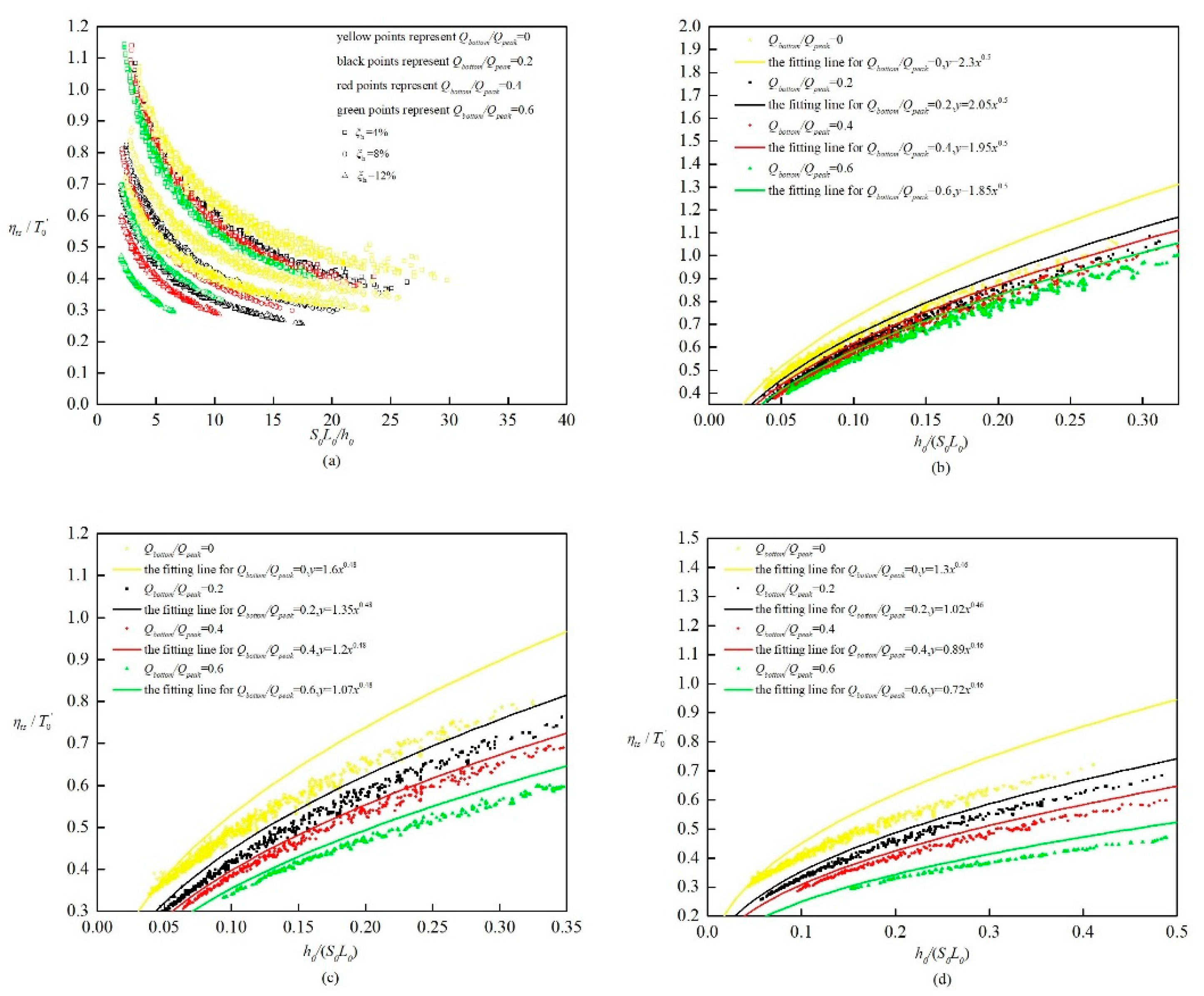3.1. The Influence of the Hydraulic Factors
Figure 1 illustrates the influence of hydraulic factors on the relative error
of KWA, including
.
Although the results showed that the maximum relative error
values of the selected tests were below 10%, these errors increased under other situations. These tests clearly showed a flattening effect on
near the downstream boundary. This flattening effect resulted from the downstream boundary condition, which the current study selected as a zero-flow-depth gradient. A change in this downstream boundary condition would result in a different effect near the downstream end [
18]. Therefore, the last 10% of the channel length was ignored, and instead
was regarded as the downstream end. Furthermore, the relative error
increased along the channel due to the existence of attenuation in DWA. Experiments by Moramarco et al. [
18] similarly illustrated this phenomenon.
The effect of each parameter on the relative error
is shown in
Figure 1. The relative error
decreased with increasing
(see
Figure 1a). Moreover, the reduction in performance of the relative error
was illustrated by increased
, decreased
, and increased
.
A more gradual variation in the upstream inflow resulted in a reduction of the relative error as according to the variation of . From test No. 5 to No. 9, increased gradually from 100 to 400, which means the difference of and decreased in the situation that the time to peak discharge remain constant. Therefore, the flow rising limb of the hydrograph are becoming gradual from test No. 5 to No. 9. Consequently, the corresponding relative error decreased gradually from 7.3% to 1.5%. The similar behavior can be seen in decreased and increased while there is something different for increased . and the difference between and will not change with the increased . However, the time zone near the maximum discharge would become gradual as increases. This behavior would also result in decreased relative error.
This phenomenon can be explained by the momentum equation of SVE (Equation (2)), which can be transformed as (see
Appendix A):
where
is the flow velocity and
is the steady discharge, which was defined in
Appendix A.
The aim to reduce the relative error
is mainly finding a situation in which less attenuation can occur in DWA. The reduction of the last three terms in the root of Equation (18) can achieve such a result. The gradual variation in upstream inflow formed by
would result in a decrease in the last three terms of the root of Equation (18). The gradual variation in upstream inflow clearly resulted in a decrease in the partial derivative of
with respect to
. The variation in the other two partial derivatives with respect to
could be identified with consideration of the numerical technique used. The numerical method described above showed that the point
was a specific average form of point
,
(see
Figure 2), and
(
and
are the temporal and spatial directions, respectively ). When gradual variation in upstream inflow results in a reduction in the difference between
and
, the difference between
and
should also decrease. The points
and
would be influenced by the earlier point on the time line
, which would promote the reduction in the difference between
and
. For the other site
j, the similar performance should be expected. Therefore, a gradual increase in the variation of upstream inflow resulted by any single variable of
would reduce the relative error
.
The influence of the four parameters of upstream inflow was considered separately in above analysis. A consideration of the joint influence of the four parameters required a parameter to be proposed to identify which inflow gradually varied. While the relative error
at the downstream end was regarded as a measure of the accuracy of KWA, more attention could be placed on maximum discharge of inflow. For this reason, the present study focused on discharge exceeding 90% of the maximum discharge and the time span
of this region was calculated for each upstream boundary condition (see
Table 2).
A clear illustration of the combined influence of the four parameters,
, was obtained by extracting the value of relative error from
Figure 1 (see
Table 3). From tests No. 5 to No. 17, the higher time span of discharge exceeding 90% of maximum discharge
always indicate the higher relative error
for any
x* (see
Table 2 and
Table 3), except for tests No. 8 and No. 12 in which the time span was the same but
of test No. 8 exceeded that of test No. 12 at
, whereas the relative error of test No. 12 exceeded that of No. 8 at all other sites. This phenomenon resulted from higher bottom discharge in test No. 8, as reflected in the high values of variables in points,
and
, when
(see
Figure 2), which would restrict the attenuation of DWA, particularly when this bottom discharge was close to peak discharge. After the gradual attenuation of peak discharge along the channel, bottom discharge became increasingly closer to peak discharge, indicating an increase in the restriction of attenuation of DWA. Therefore, the intersection of the two lines between test No. 8 and test No. 12 in
diagram was expected and the second parameter,
, should be considered to illustrate the effect of bottom discharge.
Table 3 shows that test No. 1 to No. 4 did not follow the rule of higher
with higher reliability of KWA at the beginning of the channel when compared with other tests. This phenomenon can be explained by Equation (18). A decrease in peak discharge resulted in a reduction in the last term in the root of Equation (18). For this reason, the attenuation of DWA continually decreased and the applicability of KWA improved, and the third parameter,
, was considered.
In general, the applicability of KWA could be determined by the three parameters, , , and , when only hydraulic factors were considered. The promotion of the applicability of KWA was indicated by an increased , decreased , and decreased .
3.3. Identification of Other Criteria for Kinematic Wave Approximation
The focuses of existing criteria were sometimes on overland flow in which the upstream boundary condition was ignored and lateral inflow, such as rainfall, was considered [
3,
13]. Previous studies [
12] were also interested in small perturbation of the steady state inflow. Although Moramarco et al. [
18] recognized the limitation of previous studies by considering the influence of the upstream boundary, the parameters selected were the same as in previous studies. In addition, reference discharge was defined as the average discharge expressed by Equation (17), whereas the characteristics were calculated in steady uniform flow of the reference discharge. The prevailing criteria were selected, such as
in Ponce et al. [
9] and
in Moussa and Bocquillon [
16], and the criterion considered the upstream boundary condition as in Moramarco et al. [
18], as the reference criteria and its validity was discussed.
As according to Ponce et al. [
9], the criteria which indicate the bound of 95% accuracy were as follows:
where
is the kinematic wave number,
is the Froude number of reference discharge,
is the wave period, and
is the response time of the channel.
As according to Moussa and Bocquillon [
16], the following criterion which indicate the bound of 95% accuracy can be derived:
where
represent the velocity, friction slope, and flow depth of reference discharge, respectively.
Moramarco et al. [
18] demonstrated a decrease in the relative error
with increasing kinematic wave number and
, and when
and
, the relative error
fell below 10% for any wave period.
Each test could be identified by these criteria. In
Figure 4a, the tests for the effects of variations in hydraulic factors and geometrical factors are illustrated separately in the
diagram, with the line of criterion by Ponce et al. [
9] used for comparison. It is clear that the position of each numerical test was below the line of Ponce et al. [
9]. The relative error
values of tests for hydraulic factors and geometrical factors ranged from 1.5% to 7.3% and from 7.3% to 52%, respectively. Therefore, the criterion of Ponce et al. [
9] resulted in the relative error
falling far below 1.5%. The numerical tests showed that the decreased relative error
resulting from each geometrical factor was due to the contribution of the
. Therefore, the applicability of KWA due to each geometrical factor followed the criterion of Ponce et al. [
9]. However, the influence of the hydraulic factors
followed the criterion of Ponce et al. [
9], whereas the influence of
did not. When considering all hydraulic factors and geometrical factors together, the resulting relative error
was not equivalent along the line
. In addition, the higher value of
in some tests could not be regarded as a lower relative error
, particularly when one test was for hydraulic factors and the other was for geometrical factors. Therefore, the criterion of Ponce et al. [
9] appeared unreasonable when considering the upstream boundary condition.
To illustrate the criterion of Moussa and Bocquillon [
16], two dimensionless parameters were selected as the coordinate axis, as shown in
Figure 4b. The restriction of the Froude number is not depicted in the figure, whereas all numerical tests satisfied the limitation. The results of numerical tests clearly fell on both sides of the line of the criterion by Moussa and Bocquillon [
16]. Therefore, the criterion by Ponce et al. [
9] appeared to be more restrictive than that by Moussa and Bocquillon [
16]. Moramarco et al. [
18] came to the same conclusion. By calculating the parameter
for each numerical test following the criterion by Moussa and Bocquillon [
16], it was found that the variation in relative error
according to each geometrical factor followed the criterion of Moussa and Bocquillon [
16]. However, certain abnormal phenomena could be expected when considering hydraulic factors. While the peak discharge increased with increasing relative error
, the value of
unexpectedly increased. Therefore, both the rules of Moussa and Bocquillon [
16] and Ponce et al. [
9] faced similar uncertainties.
Although the numerical results of each test were similar to results obtained by Moramarco et al. [
18], the criterion followed was too limiting. A definite formula to evaluate the applicability of KWA does not exist, and instead an inequality (
) with 90% accuracy was present. In addition, some conditions were not considered in the analysis of KWA, such as the initial state of the channel (the base discharge used in the present paper). Under circumstances in which real cases were of a sufficient complexity that not all parameters satisfied the criterion, the application of KWA would cause some confusion.
In general, the existing criterion of KWA could, to some degree, be used to illustrate variation in relative error . However, some situations exist in which these criteria would be questionable.
3.4. Improvement to the Criterion for Kinematic Wave Approximation
The most original approach for considering the reliability of KWA involves reducing the extra terms of DWA to be sufficiently small compared to the kinematic wave to be ignored. The dimensionless form of the 1-D SVE would be better to determine which term can be ignored. Each variable was substituted as follows.
where
are the dimensionless flow depth and flow velocity, respectively,
is channel length, and
and
are the flow depth and flow velocity of the reference discharge, respectively.
Under the expression of the dimensionless variables in Equation (21), the dimensionless form of the momentum equation in 1-D SVE could be expressed as follows.
Under situations in which the kinematic wave number in Equation (22) far exceeded the value of the three terms on the left-hand side of Equation (22), DWA would approach KWA. Therefore, the value of kinematic wave number and the three terms at the left-hand side of Equation (22) can be used to determine the applicability of KWA. Clearly, the direct calculation for each partial derivative would be somewhat difficult, and therefore, some parameters, which can be regarded as indicators of these terms, were selected. Considering the relative error as being the determined value, the reference discharge was selected as the peak discharge of upstream inflow. In addition, the top-most area of the upstream inflow determined the maximum flow depth along the channel. Therefore, the gradient of the top-most area of the upstream inflow representing the influence of a partial derivative of velocity with respect to and the indirect impact on the partial derivative of velocity with respect to should be considered. Therefore, was used. Furthermore, the bottom discharge of upstream inflow also influenced the partial derivative of velocity with respect to . Therefore, the present study considered . The aforementioned three parameters () represent the effects of the kinematic number and the three terms in left-hand side of Equation (22).
Some adjustments were made to these three parameters to obtain the dimensionless form, and the expressions used were
(which equals
),
, and
. The relative error
for different values of these three parameters were calculated to facilitate a good illustration of the influence of these three parameters on the applicability of KWA (see
Figure 5). The variation in hydraulic factors and geometrical factors were considered together. The numerical tests were designed so that
,
, and
varied from 1.1 to 1.5 with an interval of 0.05,
varied from 0.01 to 0.05 with an interval of 0.002,
varied from 0.0002 to 0.0008 with an interval of 0.0001, and channel width and length were 100 m and 60 km, respectively.
The isolines of relative error
could be defined for each
(see
Figure 5) while the
x-axis was
and
y-axis was
. In other words, while there was a definite
, the value of
and
could be used to define the applicability of KWA. In addition, changes in
resulted in changes in the values of
and
, which were used to define a definite relative error
.
Figure 5 also shows that the isolines fluctuated within a narrow range. This is because that the parameter
was not so extremely accurate to express the steepness of the upper area in the discharge hydrograph. Time span
was calculated by intercepting the upper 10% area of the discharge hydrograph, whereas it was also possible to use the 5% boundary of this area to determine it. In addition, variation in the factors
and
would result in an occasional situation in which the higher time span of the upper 10% of the discharge hydrograph was with the lower time span of the upper 5% of the discharge hydrograph. Although many factors were responsible for different values of
and
, this isoline could not be absolutely straight. Therefore, these errors can be ignored due to their insignificant influence and because the patterns expressed in
Figure 6 remained clear. In addition, the time span calculated in the upper 10% of the discharge hydrograph was found available to represent the steepness of the hydrograph under most situations.
The present study did not consider variation in channel width and length. The influence of channel width would be similar to that of the Manning coefficient and would only result in a change to the Froude number. The influence of channel length was considered in both
and
. To avoid redundant calculations, the influences of these two parameters were only verified in
Figure 6.
Figure 6 shows that for a definite
under different channel lengths and widths, the isolines also formed with small fluctuations. It is reasonable to deduce that this characteristic would be shown for other
. For this reason, it can be concluded that the influence of channel length and width were considered in the parameters
and
, and the results shown in
Figure 5 were valid for other channel widths and lengths.
As shown in
Figure 7a, the points in the isolines were extracted for each
when the relative error
was equal to 4%, 8%, and 12% to better illustrate the variations in isolines for each
.
An increase in
resulted in the isoline of the relative error
moving left. Under this situation, the original position in the diagram showed a reduced relative error
, indicating that relative error decreases for higher
. The fitting line was drawn for each group of points shown in
Figure 7a to depict the relationship expressed by each group of points.
Table 4 shows the fitting relationship of each group of points.
Figure 7a and
Table 4 show that the relationship for the definite relative error
between
and
(which equals to
) can be generalized to
. With results of any case falling within the upper area of this line, the relative error
would be below the corresponding value. The parameter
could be used to define the expression of the isolines of the corresponding relative error
. The corresponding value of this parameter was equal to the value
for each case shown in
Table 4.
Table 4 shows that the value of
varied in a small range for each relative error
, which complicated this criterion. This criterion could be made more practical by adjusting the value of
to a constant for each relative error
(see
Table 5).
The line shown in
Table 5 was slightly higher than the original line shown in
Table 4, as illustrated in
Figure 7b–d. These lines were adjusted to be higher than most of the corresponding groups of points (see
Figure 7b–d). Therefore, the relative error
expressed by these lines in
Table 5 was smaller than that of the original lines shown in
Table 4, which facilitated the indication of the relative error
of the corresponding isolines.
The criterion shown in
Table 5 was more practical to apply. The exponent of
was constant for the definite relative error with any value of
. In addition, only the ratio between
and
changed for each
. For a relative error of 4%, the parameter
was calculated for each case, and the ratio between
and
listed in
Table 5 would be the standard to evaluate
for cases in which a reliable KWA was obtained. Interpolation was used to obtain the ratio between
and
when
was between two values shown in
Table 5.
3.5. The Application of the New Criterion
A river reach of the Tiber River, Central Italy, which was used in the study by Moramarco et al. [
18], was also used in the present study. The river reach is regarded as a rectangular prismatic channel and
Table 6 shows the characteristics of the geometry of this reach. Two flood processes which occurred in this river reach were selected.
Table 7 shows the corresponding characteristics of the upstream inflow.
All values of
in these two cases fell far below 0.2, and could therefore be regarded as 0. The parameter
was calculated for each case (see
Table 8). For case 1, the value of
approximated to the corresponding quotient in
Table 5, indicating that the relative error
of case 1 was slightly higher than 8%. In addition, in the same way, the relative error
of case 2 was below 4%. The maximum flow discharges for these two cases at the downstream end were 184.4 and 460.9 m
3 s
−1, respectively, and the corresponding flow depths were calculated as 2.54 and 4.52 m, respectively, under an assumption of steady uniform flow. Therefore, the relative error
values could be calculated for both cases and were equal to 8.4% and 3.2%, respectively, indicating that the new criterion was reliable.
Some factors would influence the relative errors in these two cases. First, the measured results at the downstream end were used to calculate the relative error . In addition to some other uncertainties, the attenuation in reality along the channel would be higher than that of DWA, whereas the geometry of the reality would be more complicated. Therefore, the calculated relative error would be much higher. Second, since uniform flow was assumed to calculate the maximum flow depth, the influence of the dynamic wave was ignored. In addition, the slightly lower maximum flow depth at the downstream end was expected, and therefore, the calculated relative error was lower. This criterion can be considered applicable since it was an estimation of the reliability of KWA in comparison to DWA.
